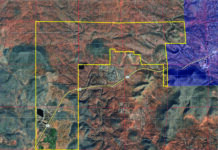Starting next week, the Arizona Department of Transportation will resume construction on State Route 260 between Cottonwood and Camp Verde.
The final work will involve paving the surface of the newly renovated road between the two towns and the most heavily trafficked stretch of road in the Verde Valley. Not only is the arterial road important for the economies of Cottonwood and Camp Verde, as workers traverse the stretch to and from work, many drivers heading to Sedona use it rather than the clogged State Route 179 through the Village of Oak Creek into Sedona.
It is a geographical oddity that the State Route 260 junction with Interstate 17 is equidistant to the Coffee Pot Road and State Route 89A intersection, whether drivers take State Route 260 off Interstate 17 or the exit onto State Route 179.
On an light traffic day, drivers on both routes will reach the Sedona intersection 29 miles away in about 37 minutes.
Of course, we rarely have these light traffic days from Wednesday through Sunday, as traffic backs up to a crawl on State Route 179, making the State Route 260 option much faster.
When the new four-lane road gets its final resurfacing to make it smoother, and local drivers feel more comfortable traveling at velocities closer to the speed limit, the route will likely be the preferred faster way for locals heading home from Prescott or Phoenix.
Tourists, however, will still likely take State Route 179 into Sedona because, on a map, it appears closer to the interstate. For drivers who use GPS mapping applications, most programming algorithms give drivers the shortest physical distance by default rather than the shortest travel time, shunting many to State Route 179.
Even though driving through Cottonwood to Sedona will technically be faster by travel time, traveling 15 miles west of Sedona to then taking 11 miles back to the east appears illogical when, on a map, State Route 179 heads due north from Interstate 17.
While the city has made inroads with ADOT to improve signage along Interstate 17 in the Flagstaff area and south of Camp Verde trying to educate drivers about using alternate routes, these mainly treat the symptoms of State Route 179’s traffic backups, not the root causes of the problem: It is a one-lane road where a two-lane road is needed and there are zero alternate routes off the road to connect with other parts of the city.
Once a driver heading north passes Beaverhead Flat Road, they are effectively stuck on the same single road as everyone else with no way out until reaching the Ranger Road intersection west of Tlaquepaque — or the Schnebly Hill Road roundabout if they have four-wheel drive, high clearance and an adventurous desire for off-roading.
The probability that ADOT will come back to Sedona and widen State Route 179 to four lanes is pretty slim, considering homeowners along it fought tooth and nail against widening the road the way ADOT wanted in the early 2000s.
ADOT gave Sedona the “improved” State Route 179 city leaders at the time wanted and it will likely take major vocal public support, a motivated Sedona City Council and begging for ADOT to come back and provide Sedona with the highway it needed two decades ago.
This council and previous councils have lacked the political will to provide that type of leadership. It’s clear that council members who balk on major road projects after getting a few angry emails or a handful of nasty phone calls from a metric smidgen of residents aren’t going to act, no matter how much the overwhelming majority of the community demands something be done. Perhaps the next batch of council candidates will be willing to ignore the squeaky wheels to build the roads we need.
It’s pitiful that, to alleviate our traffic issues, Sedona residents must rely on ADOT’s work in Cottonwood or on the federal government with the new Verde Connect project to connect State Route 260 and Cornville Road in order to take traffic pressure off our streets.
— Christopher Fox Graham
Managing Editor




















